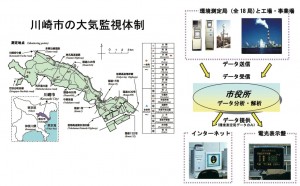Initiatives of Kawasaki City to Overcome Pollution Problems(1)
Kawasaki City implemented antipollution measures ahead of the national government. To provide relief to pollution victims, the city government put in place a pollution victim relief scheme and tightened measures on polluting sources by signing air pollution prevention agreements with 39 factories. With the enactment of the “Kawasaki City Ordinance for Pollution Prevention,” the city put more rigorous pressure on factories to deal with pollution. It also put in place systems for dealing with pollution such as the Pollution Monitor Center and Pollution Research Laboratory.
Even today, measures to respond to and prevent pollution are essential. In recent years, the city is focusing its efforts on measures to control nitrogen oxides.
Chronology of the main antipollution measures taken by the city
| Year | main items |
|---|---|
| 1960 | Promulgation and enactment of the Kawasaki City for Pollution Prevention(former ordinance) |
| 1968 | Establishment of a continuous monitoring system for sulfur dioxides,etc.through the use of centralized air pollution monitoring equipment. |
| 1969 | Establishment and enforcement of “Regulations concerning Relief Measures for Persons Affected by Air Pollution ” and the begining of relief for pollution victims. |
| 1970 | Commencement of agreements signed with 39 factories within Kawasaki City regarding the prevention of air pollution to tighten antipollution measures aimed at polluting sources |
| 1972 | Promulgation of the Kawasaki City Ordinance for Pollution Prevention,introduction of regulations on total emissions on total emissions, and completion of the Pollution Monitor Center |
| 1976 | Publication of the Promulgation of the Kawasaki City Ordinance on Environmental Assessment and the introduction of a mechanism to prevent environmental degradation before it occurs |
| 1978 | Completion of an automatic system for monitoring nitrogen oxides at the source of release (achievement of the environmental standard for sulfur dioxide concentrations at 32 major factories in the city in all major areas) |
| 1979 | Concentration of sulfur dioxide reduction achieved by satisfying the environmental standard in the entire city area |
| 1999 | Establishment and promulgation of the Kawasaki City Ordinance for Conservation of Living Environment including Pollution Prevention |
The signing of agreements between the city and businesses
Kawasaki City entered into air pollution prevention agreements with the major factories in coastal areas which accounted for 90% of the city’s heavy oil consumption.
- Formulation of an air pollution prevention plan
- Measures to be taken when a pollution warning is issued (for example, reducing operating hours, etc.)
- Consultation regarding the installation of facilities
- Measures and reporting at the time of accidents
- Reporting on fuels used
Strengthening of regulations and introduction of regulations on total emissions
In 1972, Kawasaki City published an ordinance that included the regulation of total emissions ahead of the national government.
Continuous monitoring of the atmospheric environment
The Kawasaki City Pollution Monitoring Center continuously monitors pollution in the atmosphere through its 18 monitoring stations spread throughout the city. It also uses an automatic monitoring system to automatically check emissions of major factories at the source of release.


Economic and Labor Affairs Bureau
Kawasaki City
1, Miyamoto-honcho, Kawasaki-ku, Kawasaki City, Japan, 210-8577
Tel:+81-44-200-2335
e-mail:28ecotech@city.kawasaki.jp

